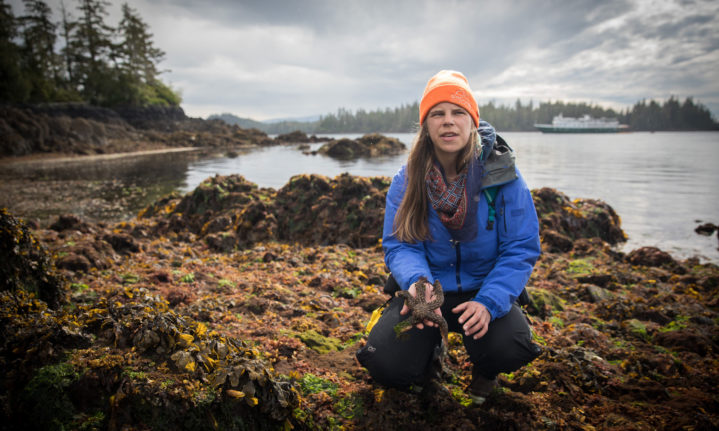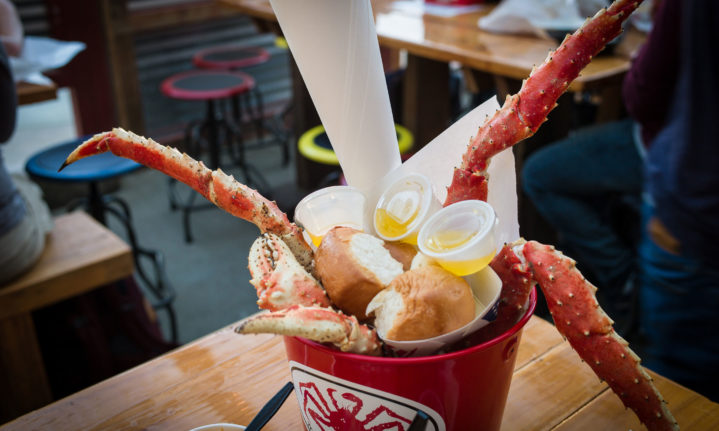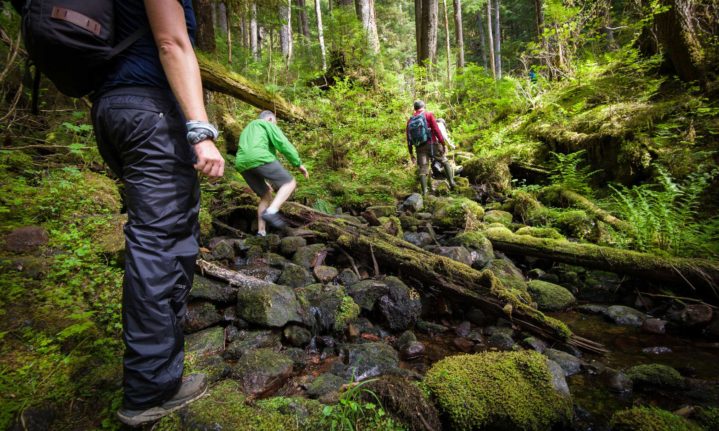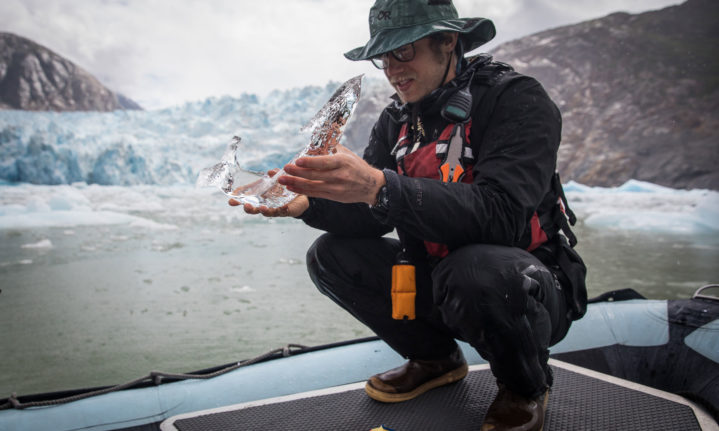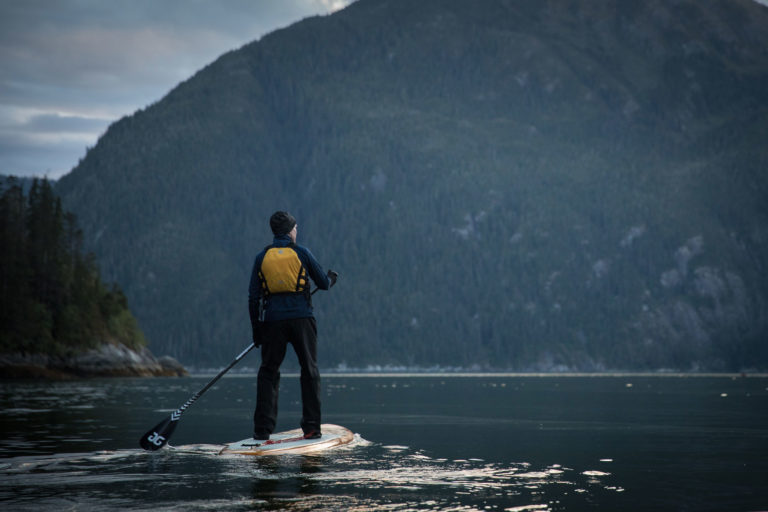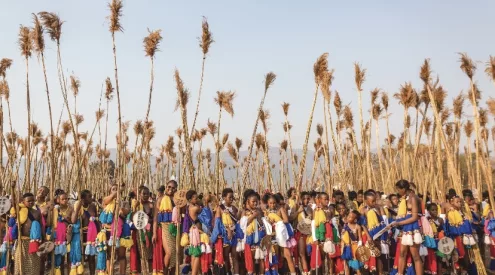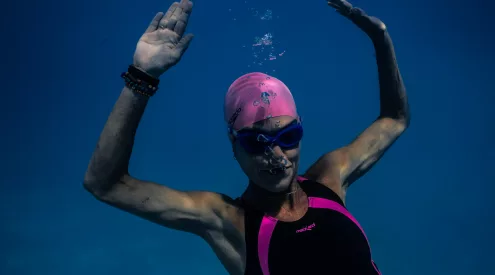The best way to explore Alaska’s wild and scenic Inside Passage is from the water, aboard an intimate and expedition-equipped ship that’ll shatter your preconceptions of cruising.
Words & photographs Morgan Trimble

While huge cruise ships carry up to 5,000 passengers, the Wilderness Explorer maxes out at 74. Image: Morgan Trimble.
‘Goooooooood morning, Wilderness Explorer,’ expedition leader Sarah Bernstein’s cheerful voice boomed over our cabin intercom. ‘Take a peek outside at sunrise over Misty Fjords National Monument.’
The day before, five family members and I had embarked on UnCruise’s Alaska Fjords and Glaciers voyage through the Inside Passage, from Ketchikan. It’s a quaint town famous for salmon, totem poles and temperate forests that soak up some 4,000 millimetres of rain each year. We weighed anchor under sunny skies as seaplanes buzzed overhead. Our first dinner was local halibut, then we stared in awe from deck as a humpback whale glided under a rising full moon.
After such an exciting start, I didn’t want to miss a thing. I jumped up and flung open our door to the starboard deck. Strange rock formations jutted from islands like abandoned castles coated in conifer trees. Misty Fjords is a protected wilderness area covering a million hectares of wild forests and glacier-carved waterways. Our route left the main channel to explore Rudyerd Bay where 900-metre cliffs closed in around us. The advantage of a small-ship like this is visiting remote coves that the big ships can’t. The Wilderness Explorer, at 57 metres long with a shallow draft, can go almost anywhere.
The other advantage is getting off the vessel to explore as often as possible. By midday, we reached Walker Cove for our first activity. Sarah split the ship’s 74 guests by preferences between boating, kayak 101 or kayak touring. With a bit of experience paddling in Cape Town, we opted for kayak touring, launching from the ship’s dock without wetting our feet and paddled seven kilometres with guide Ben Marolf. Slicing through calm water on a rare clear day in Misty Fjords, we zigzagged between waterfalls and studied marbled murrelets and pigeon guillemots – seabirds from the auk family. Ben called the former a baked-potato bird for its resemblance to a spud.
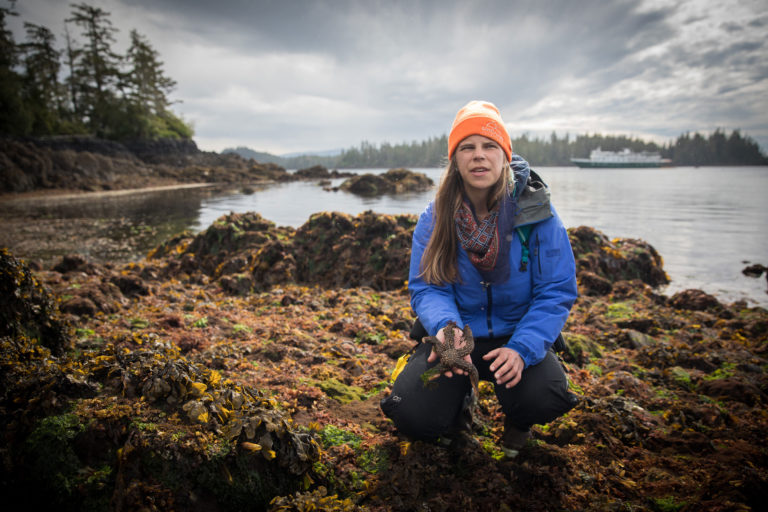
Guide Michelle Dutro shows off the diversity of intertidal life in Southeast Alaska. Image: Morgan Trimble.
While we slept that night, the ship whisked us to the Blashkes – an archipelago in the Clarence Strait – where marine-biology enthusiast and guide Michelle Dutro led a beach walk. Shod in gumboots, we combed the seaweed-slicked shore as she described the intertidal world. Limpets clung, starfish dazzled, sea squirts squirted, isopods scuttled, a sculpin fish reigned over its tide pool. It was tough to find a place to step without squishing something, and I felt bad crushing the odd barnacle. She explained that increasing carbon dioxide in the sea is sadly weakening their shells.
In the afternoon, we joined Ben on a boat tour under moody skies, motoring between islands on the Alaskan equivalent of a Zodiac – a rigid-bottomed boat with inflatable sides. Between watching bald eagles, harbour seals, sea otters and cute harlequin ducks, we stopped to sample local delicacies. Perhaps ‘survival food’ is a better descriptor for citrusy-tasting spruce tips (the spruce’s new growth) and kelp pickles (salty slivers cut from bull-kelp stalks). Ben grabbed some Methuselah’s beard lichen that dripped from the trees and explained its use for bedding and medicine.

A curious American mink couldn’t let our inflatable boat pass its territory without coming to investigate. Image: Morgan Trimble.
We heard more about lichens from Karen Dillman, a US Forest Service ecologist and special-guest host on our cruise, whom we affectionately called the Lichen Lady. The Tongass National Forest, at three-and-a-half times the size of Kruger National Park, covers most of Southeast Alaska. Nearly a third is designated wilderness and it must remain pristine and free of the signs of humans. Although Southeast Alaska has some of the cleanest air in the world, Karen and the Forest Service track pollutants absorbed by lichens to monitor cruise-ship emissions.
Overnight, we arrived at the Wrangell Narrows, a winding channel too tight for big ships. Our captain navigated the 35-kilometre run between illuminated buoys to dock in Petersburg. After a cultural presentation by a native Tlingit Alaskan, we set out to explore. This fishing village with Norwegian heritage is, like most Southeast Alaskan towns, not connected to much of anything by road. So there’s a maze of docks that serve as the town’s ‘parking lot’. Near Petersburg’s baseball field, we checked out a muskeg (peat bog) with centuries-old stunted trees and tangles of moss and carnivorous plants.
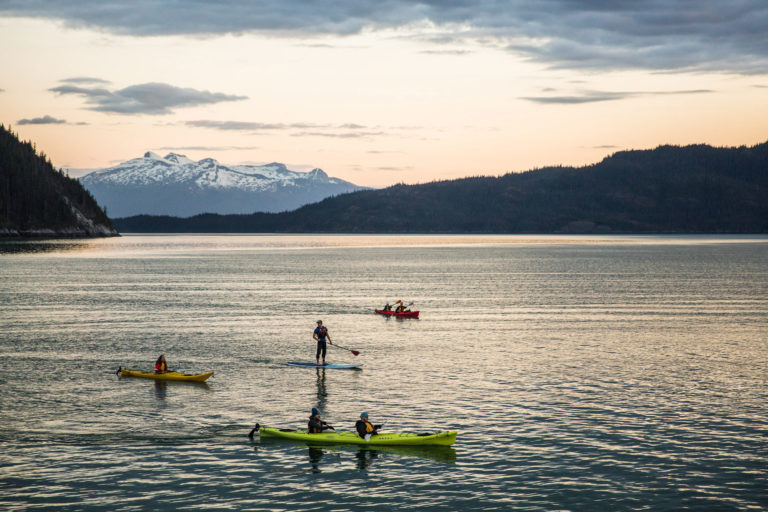
Splash skirts and rain jackets keep kayakers warm and dry on a sunset paddle around Scenery Cove in Thomas Bay. Image: Morgan Trimble.
We reboarded the ship in time for cookie hour (every day at 3.30pm and even better than 5.30pm happy hour). After dinner, there was time for a quick sunset paddle around the appropriately named Scenery Cove.
By morning, our ship was anchored in Thomas Bay and we boated to shore and the Cascade Trailhead. As usual, Sarah split up the passengers by preference. We joined the hard-charging hiking group. On the beach, Ben reviewed protocol for a bear encounter: ‘Huddle up and form a protective ring around your guide.’
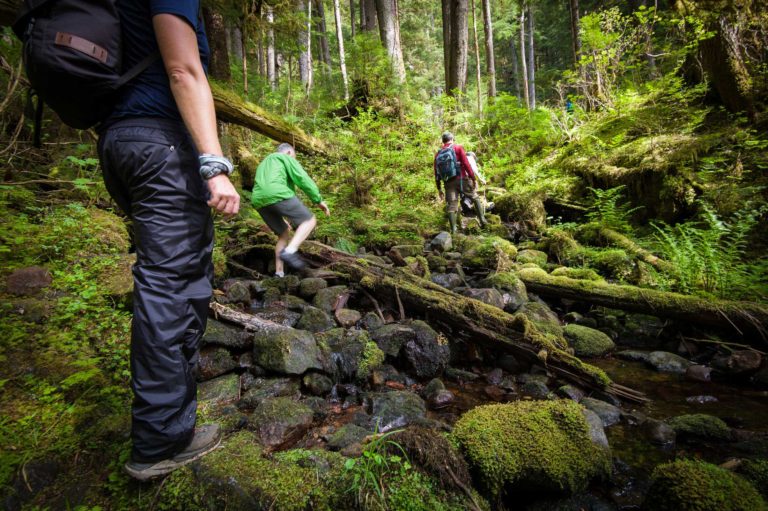
The Cascade Trail in Thomas Bay is maintained by the US Forest Service in the Tongass National Forest. It’s accessible only by boat. Veteran outdoorsmen here swear by hiking in the ‘Alaskan Sneaker’ ie gumboots. Image: Morgan Trimble.
Setting off under a canopy of massive spruce and hemlock trees, we snaked through ferns, over gnarly roots, past waterfalls and around boulders. The Tongass encompasses the largest remaining temperate rainforest on Earth. Patches of old growth are called ‘cathedral forest’, but, to me, the splendour eclipses even the grandest church. Intricate details add to the found its name in the Forest Service lichen brochure: ‘fairy barf’.

The bald eagle is prominent in Native American culture and is a popular totem-pole motif. Image: Morgan Trimble.
During a break, guide Andrew Bergstrom recounted ‘The Strangest Story Ever Told’, a legend about a gold prospector who searched these mountains in 1900. He reported running for his life from smelly devils covered in long hair and oozing sores. If you believe in hauntings, Thomas Bay is a good place to get the creeps. In 1750, a landslide wiped out a Tlingit village, killing more than 500 people. Yet, some speculate that the Thomas Bay monsters are neither ghosts nor devils. They’re kushtaka, the mythical half-man-half-otters from Tlingit folklore. Kushtaka mimic cries of women in distress to lure their victims, whom they invariably rip to shreds or turn into fellow kushtaka. On the return hike, we picked up the pace a little.
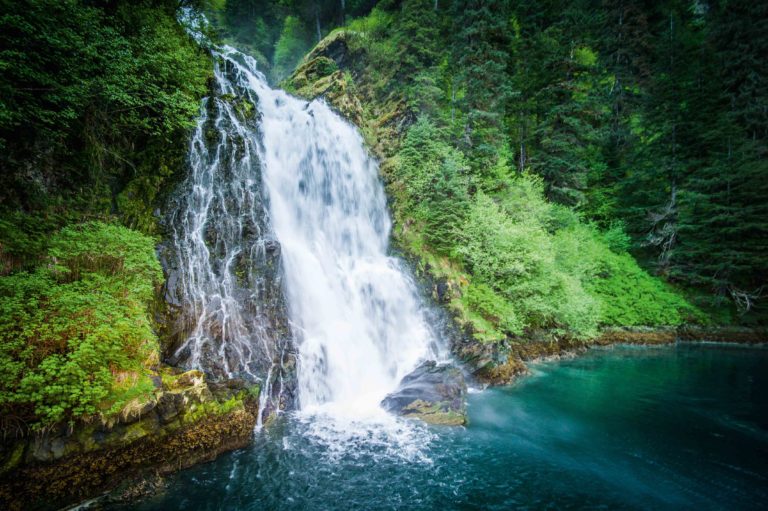
Glacier-carved fjords are a breeding ground for waterfalls – this is in Red Bluff Bay. Image: Morgan Trimble.
Another day, another wildlife-watching boat tour, this time amid the Keku Islands. We peered through clear water to rock shelves that are home to anemones, starfish and nudibranchs. Some gutsy people squeezed into thick neoprene to go snorkelling. In the afternoon, we kayaked loops around Halleck Harbor, playing hide-and-seek with otters and loons. Afterwards, we cruised across Chatham Strait to visit a waterfall in Red Bluff Bay. The skilled crew pulled the ship so close that the waterfall splattered onto the deck.

The ancient ice at the bottom of glaciers like South Sawyer in Tracy Arm Fjord appears deep blue because the air bubbles have been squeezed out. Image: Morgan Trimble.
The first icebergs floated past the next morning as we navigated Tracy Arm Fjord. We spent the morning at South Sawyer Glacier, approaching as close as we dared by inflatable boat. Intermittently, huge chunks of the glacier calved and crashed into the sea, triggering cheers and rippling waves. Through binoculars, specks at the electric-blue glacier face became terns and gulls foraging in freshly churned water. The glacier was still 800 metres away and deceptively colossal. Unexpectedly, a panicked black bear floated towards the glacier on an iceberg. We thought it might have fallen asleep on ice attached to shore, and the tide had carried it away. With difficulty, the bear made a swim for the bank and scaled the steep canyon wall to safety.

Tidewater glaciers like South Sawyer can create icebergs as big as buildings, but guide Ben Marolf grabbed a manageable example during our inflatable boat excursion. Image: Morgan Trimble.
Ben plucked ice from the sea to save for a whisky later – and we’d need one. It was time for the polar plunge. At least a third of the ship’s passengers willingly cannonballed into the frigid water with the glacier as a backdrop. The cold shock was so great, I could hardly tell when I’d kicked back to the surface and could breathe again. The onboard hot tub was more inviting than ever.
In the afternoon, we watched a school-bus-size chunk crack loose from Sawyer Glacier. This spectacular process has eroded over two kilometres of glacier since the 1980s. As we travelled the 40 kilometres back out of the fjord, Karen pointed out the glacial history written in the vegetation – bare rock at the glacier face, transitioning to moss, then shrubs, then short trees, then taller…
In Stephens Passage, a pod of orcas waved us on towards Juneau, and we disembarked in the morning with sad goodbyes. We were eager to explore Alaska’s capital and onwards. Only now, we had to figure out our own plans, find maps, organise meals, hire trans-port and guide ourselves. We missed the ship, but more than anything, we missed Sarah. Is there such a thing as an expedition leader for everyday life?
Plan your trip
GETTING THERE
Alaska’s capital, Juneau, is 16,000km from Joburg. Break up the journey with a stopover in Europe, Canada or the USA, from where you can fly Alaska Airlines out of Seattle to your cruise departure city – likely Ketchikan or Juneau – from R4,200 return. alaskaair.com
COST AND BOOKING UnCruise Alaskan itineraries for 2020 start at R48,000 pp sharing for seven nights. uncruise.com
WHEN TO GO
The Alaskan cruising season stretches from April to September. Early season (spring) is cheaper and sunnier. Summer is more crowded but with long days for exploring. From July, spawning salmon pack the streams and tempt bears and eagles to congregate. On the season’s first and last voyage, ships travel between Seattle and Alaska on extended trips.
NEED TO KNOW
You can’t get around Southeast Alaska by road – only by sea or air. Small-ship cruises are expensive compared to traditional cruise liners. If you don’t mind crowds or watching nature from afar, big ships offer affordable options (often with major special offers). But small-ship cruises are generally all-inclusive, so when comparing prices, factor in the additional cost of shore excursions you’d book on a traditional cruise. DIY types can piece together an adventure using Alaska’s state-ferry system.
DO THIS
UnCruise offers a variety of itineraries on six small ships in Alaska. The Wilderness Explorer’s 37 cabins vary in price by class. Lindblad Expeditions (expeditions.com) and Alaskan Dream Cruises (alaskandreamcruises.com) offer similar small-ship trips.
The hardest part is deciding what activities to sign up for each day. Kayaking, hiking and inflatable-boat touring get you off the ship. The expedition leader groups guests by experience and fitness level, so you’ll feel comfortable. Onboard, join sunrise yoga classes or relax in the outdoor hot tub with a drink and epic views.
STAY HERE
In Ketchikan, book the Cape Fox Lodge (around R1,500 pp) perched high on the hill with a funicular from the lobby down to the renowned Creek Street. capefoxlodge.com
In Juneau, the Sheraton Four Points (around R1,787 pp) is across from the UnCruise dock and in walking distance to downtown attractions. four-points.marriott.com
EAT AND DRINK
Food and drink onboard is included in the cost. In Juneau, try an enormous king-crab leg at Tracy’s King Crab Shack (R417) or street-food salmon tacos at Deckhand Dave’s (R223). In Ketchikan, visit the century-old Annabelle’s Keg and Chowder House for a trio of chowders (R327) or halibut and chips (R300).
This article was first published in the April 2020 issue of Getaway magazine.
Get this issue →
All prices correct at publication, but are subject to change at each establishment’s discretion. Please check with them before booking or buying.










